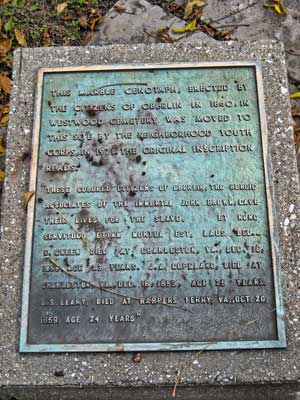
Follow workers.org on



RED HOT: TRAYVON MARTIN
CHINA,
AFGHANISTAN, FIGHTING RACISM, OCCUPY WALL STREET,
PEOPLE'S POWER, SAVE OUR POST OFFICES, WOMEN, AFRICA,
LIBYA, WISCONSIN WORKERS FIGHT BACK, SUPPORT STATE & LOCAL WORKERS,
EGYPT, NORTH AFRICA & MIDDLE EAST,
STOP FBI REPRESSION, RESIST ARIZONA RACISM, NO TO FRACKING, DEFEND PUBLIC EDUCATION, ANTI-WAR,
HEALTH CARE,
CUBA, CLIMATE CHANGE,
JOBS JOBS JOBS,
STOP FORECLOSURES, IRAN,
IRAQ, CAPITALIST CRISIS,
IMMIGRANTS, LGBT, POLITICAL PRISONERS,
KOREA,
HONDURAS, HAITI,
SOCIALISM,
GAZA



|
|
A monument to Harper’s Ferry combatants
Published Oct 21, 2009 3:49 PM
This monument in Oberlin, Ohio, honors the three Black town residents who
fought with John Brown at Harper’s Ferry. The accompanying plaque
explains:
“This marble cenotaph, erected by the citizens of Oberlin in 1860 in
Westwood Cemetery, was moved to this site [Martin Luther King Memorial Park] by
the Neighborhood Youth Corps. in 1971. The original inscription [now partially
worn away] reads: “‘These Colored Citizens of Oberlin, the Heroic
Associates of the immortal John Brown, gave their lives for the slave. Et nunc
servitudo etiam mortua est, laus Deo. S. Green, died at Charleston, Va., Dec.
16, 1859, age 23 years. J.A. Copeland, died at Charleston, Va., Dec. 16, 1859.
L.S. Leary, died at Harper’s Ferry, Va., Oct. 20, 1859, 24
years.’ ” Shields Green, also called “Emperor,” escaped
slavery in Virginia and was living in Oberlin leading up to the Harper’s
Ferry raid. His first meeting with John Brown was in 1858 in the Rochester,
N.Y., home of Frederick Douglass. Douglass said later, “Shields Green was
not one to shrink from hardships or dangers. He was a man of few words ... but
his courage and self-respect made him quite a dignified character.”
John A. Copeland Jr. was the son of prominent Oberlin abolitionists John
A. Copeland Sr. and Delilah Evans Copeland. He was recruited to
Brown’s army by his uncle, Lewis Sheridan Leary. Both Leary and Copeland
had participated in the “Oberlin-Wellington Rescue”—the
freeing of escaped slave John Price from a hotel in Wellington, Ohio, where he
was held captive by slave catchers in 1858.
Leary was wounded in battle and died eight hours later. Green and Copeland
were hanged two weeks after the hanging of John Brown. An abolitionist
minister, James Monroe, failed in his attempt to recover their bodies so their
families could give them a proper burial. White medical students insisted the
bodies were theirs for dissection purposes.
Leary’s widow, Mary Leary, later married another prominent Oberlin
abolitionist, John Mercer Langston. One of the couple’s grandsons was the
renowned poet Langston Hughes.
Ohio has other strong connections to the heroes of Harper’s Ferry. A
white abolitionist from Salem, Edwin Coppock, was hanged for his participation
in the raid on the same day that Green and Copeland were executed. Brown
himself lived in Ohio on and off for a total of 35 years. Six days before
his execution, Copeland wrote in a letter to his brother: “It was a sense
of the wrongs which we have suffered that prompted the noble but unfortunate
Captain Brown and his associates to attempt to give freedom to a small number,
at least of those who are now held by cruel and unusual laws, and by no less
cruel and unjust men. To this freedom they were entitled by every known
[principle] of justice and humanity, and for the enjoyment of it God created
them. And how, dear brother, could I die in a more noble cause?”
—Report and photo by Martha grevatt
Articles copyright 1995-2012 Workers World.
Verbatim copying and distribution of this entire article is permitted in any medium without royalty provided this notice is preserved.
Workers World, 55 W. 17 St., NY, NY 10011
Email: [email protected]
Subscribe [email protected]
Support independent news DONATE
|
|


